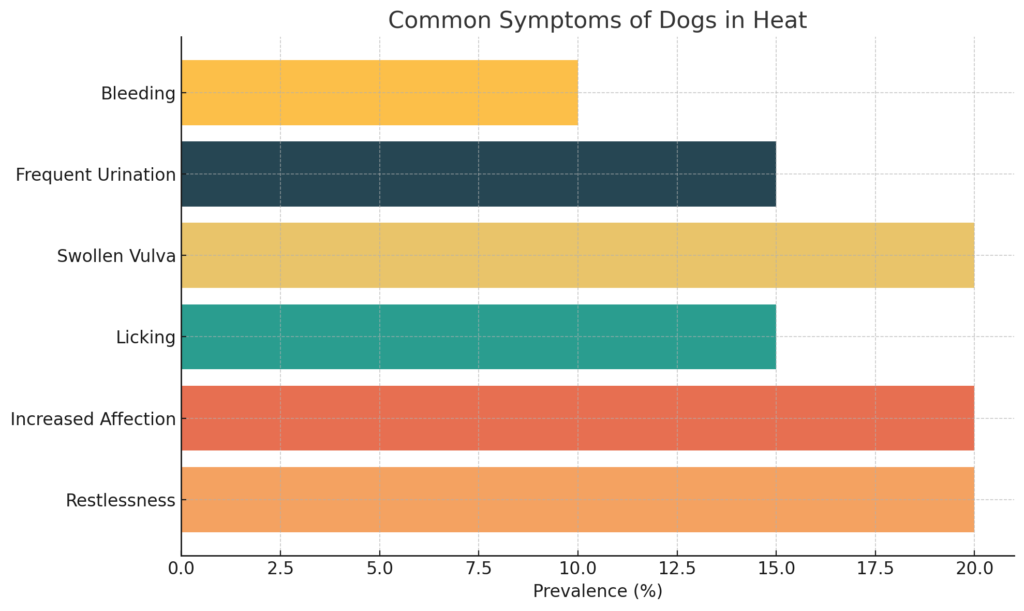
Understanding your dog’s reproductive cycle can be crucial for any pet owner. One common question that arises is, “Do dogs cramp when they are in heat?” This post will delve into the canine heat cycle, common symptoms of dogs in heat, and how to manage cramps or any discomfort they might experience.
Understanding the Canine Heat Cycle
The canine heat cycle, also known as the estrous cycle, is a natural part of a female dog’s reproductive process. It typically begins when a dog reaches puberty, which can be as early as six months old but varies depending on the breed and individual dog. Understanding this cycle is vital for responsible pet ownership and breeding practices.
During the heat cycle, a female dog’s body undergoes several changes to prepare for potential pregnancy. These changes are driven by hormonal shifts that affect her physical and behavioral state. Recognizing the stages of the heat cycle can help you manage your dog’s health and behavior more effectively.
Stages of the Heat Cycle
The heat cycle consists of four stages:
- Proestrus: This initial stage lasts about 7-10 days. During this time, you might notice your dog’s vulva swelling and a bloody discharge. She may also start attracting male dogs, but she won’t be receptive to mating yet. This stage is crucial for the preparation of the reproductive organs.
- Estrus: This stage lasts about 5-9 days. The discharge may become lighter and more watery. Your dog will be receptive to mating during this period. This is the peak fertility phase, and if breeding is intended, this is the optimal time.
- Diestrus: This stage occurs if your dog becomes pregnant or the estrus stage ends. It lasts about 60-90 days. During diestrus, the body either supports the developing pregnancy or returns to a normal state if pregnancy does not occur.
- Anestrus: This is the resting stage and lasts until the next cycle begins, typically around 4-6 months later. During anestrus, the reproductive system rests and recovers in preparation for the next cycle.
Common Symptoms of Dogs in Heat

Knowing what to expect when your dog is in heat can help you manage her symptoms better. It’s essential to differentiate between normal heat symptoms and signs of potential health issues.
Physical Symptoms
- Swollen Vulva: This is one of the most noticeable signs. The vulva can become significantly larger and more prominent, indicating the start of the proestrus stage. Monitoring the swelling can help you track the progress of the heat cycle.
- Bloody Discharge: This discharge is usually the first sign that your dog is entering heat. It may vary in color from bright red to a pinkish hue. The amount of discharge can also vary, but it’s a key indicator of the cycle’s onset.
- Increased Urination: Your dog might urinate more frequently, marking her territory to signal her reproductive status. This behavior helps attract male dogs and is a natural part of the heat process.
Behavioral Symptoms
- Increased Affection: Some dogs become more affectionate and clingy during their heat cycle. They may seek more attention and physical contact from their owners, which can be a sign of their need for comfort.
- Restlessness: You may notice your dog pacing or showing signs of anxiety. This restlessness can be due to hormonal changes and the urge to find a mate.
- Attraction to Male Dogs: Your dog will likely become more interested in male dogs and may try to escape to find a mate. This behavior is driven by instinct and can be challenging to manage without proper precautions.
Signs of Discomfort
- Whining or Whimpering: If your dog seems more vocal, it could be a sign of discomfort. Pay attention to changes in her usual vocalizations, as these can indicate pain or unease.
- Changes in Appetite: Some dogs may eat less or show a lack of interest in food. A sudden decrease in appetite can be a sign of discomfort or stress related to the heat cycle.
- Lethargy: Your dog might appear more tired or less active than usual. Reduced energy levels can be a response to hormonal changes and physical symptoms.
Why Discomfort Occurs
The discomfort is usually due to hormonal changes and physical symptoms such as swelling and increased blood flow. While it may not be the same as human menstrual cramps, it can still cause your dog to feel uneasy. Understanding the root causes of discomfort can help you provide better care.
Hormonal fluctuations during the heat cycle can lead to mood changes and physical discomfort. Swelling of the reproductive organs and increased blood flow can cause sensations that are unfamiliar and uncomfortable for your dog. Providing comfort and care during this time is essential for her well-being.
Managing Discomfort and Cramps in Dogs

As a pet owner, it’s essential to know how to help your dog manage any discomfort during her heat cycle. Proper care can make a significant difference in her comfort and overall health.
Provide a Comfortable Environment
Ensure your dog has a quiet, comfortable place to rest. Soft bedding and a warm environment can help soothe her. Reducing stressors in her environment can also alleviate discomfort and promote relaxation.
Consider creating a designated resting area where your dog can retreat when she needs peace and quiet. This space should be away from high-traffic areas and provide a sense of security.
Maintain Hygiene
Keep your dog clean to prevent infections. You can use doggy diapers to manage discharge and keep your home clean. Regularly changing the diapers and cleaning the vulva area can prevent infections and discomfort.
Hygiene is crucial during the heat cycle to avoid complications such as bacterial infections. Ensure that your dog’s genital area remains clean and dry, and consult your veterinarian if you notice any signs of infection.
Offer Gentle Exercise
Moderate exercise can help alleviate discomfort and keep your dog distracted. Avoid strenuous activities that could cause more stress. Gentle walks and playtime can provide physical and mental stimulation without overexertion.
Exercise can also help manage restlessness and anxiety. Keeping your dog engaged in light activities can improve her mood and overall well-being.
Consult Your Veterinarian
If your dog seems to be in significant discomfort, consult your veterinarian. They may recommend pain relief options or other treatments to help manage the symptoms. Professional advice is essential for ensuring your dog’s health and comfort during the heat cycle.
Veterinarians can provide tailored recommendations based on your dog’s specific needs and health status. Don’t hesitate to seek professional help if you have concerns about her well-being.
Natural Remedies
Some natural remedies can help soothe your dog:
- Herbal Supplements: Certain herbs like chamomile can have a calming effect. Always consult your veterinarian before introducing any supplements to ensure they are safe and appropriate for your dog.
- Warm Compresses: Applying a warm compress to your dog’s abdomen can help alleviate discomfort. The warmth can relax muscles and reduce swelling, providing relief from physical symptoms.
Conclusion
Understanding the canine heat cycle and recognizing the symptoms can help you provide the best care for your dog. While dogs may not experience cramps in the same way humans do, they can still feel discomfort. By providing a comfortable environment, maintaining hygiene, offering gentle exercise, and consulting your veterinarian, you can help manage any discomfort your dog may experience during her heat cycle.
Remember, every dog is different, and it’s essential to pay attention to your dog’s specific needs and behaviors. With the right care and attention, you can help your dog navigate her heat cycle with as little discomfort as possible. Being proactive and informed about your dog’s reproductive health will ensure she remains happy and healthy throughout her life.
